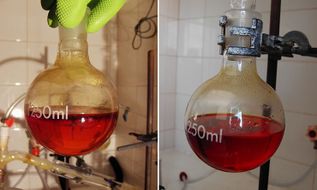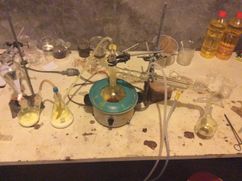Sulfur dichloride
Sulfur dichloride (SCl2) is a foul smelling red liquid created through the reaction of sulfur and chlorine.
Contents
Properties
Chemical
Disulfur dichloride reacts with water to form sulfur dioxide and hydrochloric acid, so an open container wiill produce thick white fumes as it reacts with moisture in the air. Sulfur dichloride slowly converts into disulfur dichloride.
Sulfur chlorides can be used to produce thionyl chloride.
Physical
SCl2 has a highly unpleasant odour, as well as producing HCl and SO2 which are also highly unpleasant to breathe in.
It is a bright red liquid with viscosity similar to water.
Availability
Due to air instability and pressure build-up from decomposition to the monochloride, disulfur dichloride is generally not avaliable to buy.
Preparation
SCl2 distills over as chlorine is passed over molten sulfur. This reaction may also produce disulfur dichloride.
Both sulfur and chlorine are common chemicals in a home laboratory but the synthesis of sulfur dichloride is complicated as it requires simultaneous distillation while gassing the sulfur with the chlorine which requires moderately complicated glassware such as two necked flasks or a very well improvised setup.
Projects
- Make thionyl chloride
- Make sulfur nitride
Handling
Safety
Sulfur dichloride is extremely toxic and corrosive and proper protection must be worn when working with the compound. Work should be performed in a fumehood.
Storage
SCl2 should be stored in a sealed container, in a dry cold place. As it slowly decomposes over time, it's best to open the bottle from time to time to release the pressure.
Disposal
Reaction with water destroys the compound, and this can be effective if done outside or in an area capable of safely removing the sulfur dioxide. Aqueous sodium hydroxide solutions can also be used. Calcium hydroxide suspension is also a good choice.

